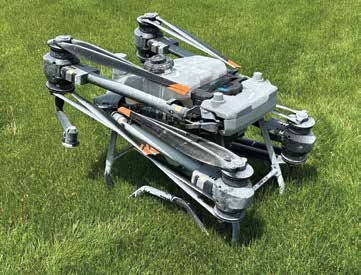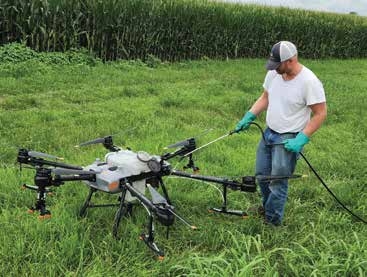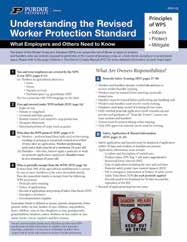8.Common Questions Regarding Spray Drone Applications
RESOURCES - PUBLICATIONS
The Evolution of Spray Drones, Their Capabilities and Challenges for Pesticide Applications
8. Common Questions Regarding Spray Drone Applications
In this section, we answer frequently asked questions about using drones for pesticide applications.
Q: Should I rinse the tank if I’m planning to use the same product tomorrow?
If you plan to use the same product the next day, the best practice is to flush out the system so that the product does not remain overnight in hoses. Remember, the higher pesticide concentration in drone tanks present greater risks to drone parts over time. As products sit in tanks and lines for extended periods, there are more opportunities for pesticide solutions and formulation solvents to seep into lines, hoses, and poly tanks. They could even allow solid residue to form on surfaces of solution tanks. Studies with blue dye show some products have the potential to remain in lines for weeks. Rinsing out the system reduces the likelihood that materials will solidify, which may corrode pumps, seals, and rubber parts.
The problem with spray drones is that there are no rinse tanks with clean water onboard to flush lines like there are with ground rigs or manned spray planes. What remains in partially filled tanks must be sprayed over the edges of fields or back over recently sprayed fields. After that, rinse drone tanks with clean water and spray it out, repeating the process several times.
Q: Should I use a tank cleaner when I switch products?
After you rinse a drone, you should use a tank cleaner when you switch from one pesticide to another or if you switch to another crop that may be sensitive to a chemical you have previously used. Just like traditional ground sprayers, when you use tank cleaners with proper technique, they will remove and break down any remaining ingredients and make them inactive.
Make sure to remove and flush out any internal screens your drones may be equipped with. Sometimes, you can remove drone spray tanks, which allow you to add tank cleaner solutions to tanks and manually shake them.

Many drone solution tanks have removable strainers that allow for easier cleaning.
Q: How do I agitate the mixture in the tank?
Currently, there are no agitation devices on spray drones. Mixing pesticides directly in the tank requires two people to pick the unit up and shake it. If you use anything other than a water-soluble formulation, it is best to make a slurry of water and the pesticide mixture in a 5-gallon bucket or a 2.5-gallon jug to get the products well suspended throughout the mixture. Another option is to use a separate mixing tank that has a built-in agitation pump to improve mixing before transferring it into the drone.
Q: Should I rinse off a drone before leaving an application site?
When drones are spraying liquid pesticide solutions, some of the spray mixture will undoubtedly get on drone exteriors. It is a misconception that you cannot rinse off a spray drone with water. Many mistakenly believe that rinsing drones damages electronic components. In reality, spray drones are largely watertight, which prevents damage to the onboard electronics when you rinse their exteriors.
Getting into a habit of rinsing drones helps remove solvents that could “gum up” moving parts and remove grime from sensors. Rinsing drones not only protects them, it also will keep unwanted residues out of the trailers or truck beds when you store the drones.
We do not recommend using any type of power washing equipment to rinse drone surfaces — water can get into electronic modules with high pressures. Periodically scrubbing drone surfaces is required to remove oily residues. In addition, removing those residues can help prevent carrying unwanted, sometimes herbicide-resistant weed seed, from one field to another.
Although the concentration of chemicals in rinse water is extremely low, it is a good idea to rinse tanks in areas far away from ditches or other areas (such as grass waterways) that present a risk of the rinse water reaching nearby water resources.
Consider using large confinement trays in your trailers or truck beds to place drones on after you rinse them. Confinement trays keep any water from dripping onto trailer and truck floors. The trays also could contain possible spills if drones still have pesticide in their tanks as you travel from site to site.
Due to the wind turbulence drones produce, pesticides are often deposited on drones, requiring thorough cleaning. Use a mild detergent solution from a squirt bottle and then rinse after a few minutes.


Dumping Product Never a Good Thing
One option for leftover solution in spray tanks you should never consider is dumping a tank’s contents on the ground.
Dumping is illegal and can lead to serious consequences with federal, state, and local regulatory authorities. It is one of the easiest ways to tarnish your reputation and image.
Q: How should I handle leftover pesticides in the tank that are no longer needed?
In a pesticide application, the guiding philosophy is that you should leave minimal product in spray tanks. Consider this principle when you are mixing pesticide solutions. Consider the size of the field to be applied or the overall job. Assume 1 gallon left in the spray tank.
Some think it would be much easier to empty a tank’s contents back into the premix tank that it was originally pulled from. However, there is always a risk that the leftover mixture is contaminated and that you would be combining contaminated mixture with uncontaminated premix. While the likelihood of that might be slim, why take the chance?
Draining tanks directly on the ground is not a good option either. There is a high risk that the person opening the drain cap under the tank will get tank mix all over their hands, arms, and legs, creating excessive chemical exposure. Then there are always the regulatory repercussions of dumping chemicals on the ground.
The only real option is to dilute leftover mixture and spray it on the field you just sprayed or around the field edges. Normally, you will need to apply less than a gallon or two. Putting herbicide products to use on field edges where weeds are normally thicker is a good idea, while insecticides and fungicides can go back over the crops. As long as the sprays from previous application have dried, going back over it a second time with drones will not wash off any previously applied products. It is important to dilute the remaining chemical mixture as to not over-apply any chemicals beyond label limits.
----------------------------------------------------------------------------------------

Purdue Pesticide Programs offers a detailed publication:
Understanding the Revised Worker Protection Standard: What Employers and Others Need to Know (Purdue Extension publication PPP-131).
It is available from Purdue Pesticide Programs (ppp.purdue.edu)
or the Purdue Extension Education Store (edustore.purdue.edu).
----------------------------------------------------------------------------------------
Q: How do I manage wind and streaking?
Streaking is a function of improper swath management. You can help prevent streaking by swath testing and adjusting application parameters (height, speed, or droplet size) to determine effective swath widths. Swath displacement caused by excessive winds can also result in streaking because product deposition will be highly concentrated in certain portions within the swath.
Q: Do I have to post and/or leave information at the field?
Following any pesticide label’s use directions includes meeting the requirements of the Agricultural Use Requirements box. This box provides further instructions about posting, reentry times, and information exchange when the area treated is a farm, forest, nursery, or enclosed space production (for example, a greenhouse). If the area being treated is not one of the above areas (for example, aquatic), consult the box called Non-Agricultural Use Requirements that is shaded and placed directly below the Agricultural Use Requirements.
For more information, see Understanding the Revised Worker Protection Standard: What Employers and Others Need to Know (Purdue extension publication PPP-131), available from the Purdue Extension Education Store (edustore.purdue.edu) or Purdue Pesticide Programs (ppp.pudue.edu).
DRONE FACT
Following a pesticide label’s use directions includes meeting the requirements in the Agricultural Use Requirements box. This box provides instructions for postings, reentry times, and information exchanges when treated areas are farms, forests, nurseries, or greenhouses.